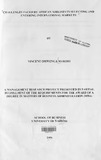| dc.description.abstract | Airline business is the fastest means of transport among countries of the world and plays a
significant role in the growth of economies all over the world. Globally, African airlines'
contribution to the world air travel is very minimal. It was therefore necessary to conduct a
study to determine the challenges that African airlines faced in selecting and entering
international markets. The objectives of the study were to determine the challenges African
airlines faced in selecting international markets and the modes of entry into international
markets.
A descriptive research design was use in this study. The population of interest was 37
International Air Transport Association (lATA) African Airline Members. A census study
was done. Primary data was collected using a structured questionnaire that was emailed/
faxed to the target respondents (managers or their equivalent involved either In
planning, marketing and government industry affairs). 16 questionnaires were filled and
returned. This represented a response rate of 43%. The data was analyzed using measures of
Central Tendency, mainly frequencies, mean scores, standard deviations and presented in
tables.
African airlines' contribution to global air transport is insignificant (36 million passengers
compared to the global figure of 1.584 billion). Most of the African airlines operate both
domestic and international markets with majority of the international destinations being
within Africa. Most of the African airlines lack the capacity to compete outside the African
markets because of tough market related conditions and the fact that on average most African
airlines operate a fleet size of less than 10 aircraft that is mainly for short haul flights.
In selecting international markets, this study found that the greatest challenge African
Airlines had to contend with was to assess the profitability, general risk and yield of the
potential market. This is because of the lack of well developed models. Despite the fact that
the industry is liberalizing very fast, African airlines were still bound by many regulatory
tendencies that hindered them from venturing into international markets. Assessing the
general risk of an entry mode and contribution of an entry mode to give an airline a
competitive edge in terms of increasing market share were the greatest challenges that
airlines faced in choosing a mode of entry. The researcher recommends that African airlines
conduct a thorough evaluation of their long term strategic orientation that would lead to
design and development of meaningful strategic alliances for that is the only way they could
overcome these challenges.
This study concentrated on scheduled carriers. Charter operators who have also entered into
international markets may have been left out in the study. The researcher recommends that
future studies be done to establish whether airlines from other parts of the world face similar
challenges as airlines in Africa and also find out how the African airlines have handled the
challenges that they face in selecting international markets and the mode of entry. | en |

